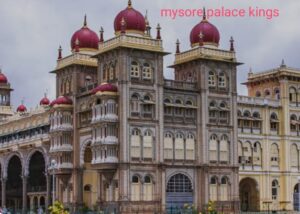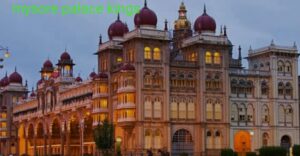Mysore Palace kings , a symbol of grandeur and architectural brilliance, stands as a testament to the opulence of the Wadiyar dynasty. Located in the heart of Mysore, Karnataka, this historical palace has been the seat of the Wadiyar kings for centuries. With its stunning Indo-Saracenic architecture and rich cultural heritage, Mysore Palace attracts millions of visitors each year, making it one of India’s most famous landmarks.

1.Mysore Palace Kings: History of Mysore Palace
The origins of Mysore Palace date back to the 14th century when the Wadiyar dynasty established their rule. The palace as we see it today, however, was constructed in the early 20th century after a devastating fire in 1897 destroyed the old wooden palace. Commissioned by Maharaja Krishnaraja Wadiyar IV and designed by British architect Henry Irwin, the new palace seamlessly blends Hindu, Muslim, Rajput, and Gothic architectural styles, creating a unique and awe-inspiring structure.
2.Mysore Palace Kings: The Wadiyar Dynasty
The Wadiyar dynasty, also known as the Wodeyar dynasty, has played a pivotal role in the history of Mysore. Established in 1399 by Yaduraya Wadiyar, the dynasty ruled the Kingdom of Mysore for more than six centuries, except for a brief period when the kingdom fell under the control of Hyder Ali and his son, Tipu Sultan. The Wadiyars were known for their patronage of the arts, literature, and culture, significantly contributing to the region’s rich heritage.
3. The Kings of Mysore Palace
Throughout the centuries, several kings of the Wadiyar dynasty left an indelible mark on Mysore Palace and its history. Among the most notable were:
– Maharaja Krishnaraja Wadiyar III (1799-1868): Known for his administrative reforms and efforts to modernize the kingdom, he also commissioned various architectural projects and promoted the arts.
– Maharaja Chamarajendra Wadiyar X (1863-1894) : His reign saw the development of modern infrastructure in Mysore, including railways and educational institutions.
– Maharaja Krishnaraja Wadiyar IV (1894-1940) : Often referred to as the “Rajarshi” or “Saintly King,” his rule is considered the golden age of Mysore. Under his patronage, Mysore Palace was reconstructed, and the city flourished in terms of culture, education, and economy.
These kings not only contributed to the architectural splendor of Mysore Palace but also played significant roles in shaping the cultural and political landscape of the region.

4. Architectural Splendor of Mysore Palace
Mysore Palace is an architectural marvel that reflects the grandeur of Indo-Saracenic design, a fusion of Hindu, Muslim, Rajput, and Gothic styles. Key features of the palace include:
– Durbar Hall: Known for its magnificent pillars and intricate ceiling, this hall was used for ceremonial gatherings and royal meetings.
– Amba vilasa (Diwan-e-Khas) : This private audience hall is renowned for its ornate doors, stained glass ceilings, and inlaid flooring.
– Gombe Thotti (Doll’s Pavilion) : Displaying a collection of traditional dolls and artifacts, this pavilion is a unique feature of the palace.
The exterior of the palace is equally breathtaking, with its domes, arches, and turrets creating a majestic silhouette against the Mysore palace.
5. Cultural Significance
Mysore Palace is not only an architectural wonder but also a cultural hub. The palace is the epicenter of the grand Dussehra celebrations, a 10 day festival that showcases the rich cultural heritage of Karnataka. During this festival, the palace is illuminated with thousands of lights, creating a spectacular sight that attracts visitors from around the world.
The Wadiyar kings were great patrons of the arts, and the palace has played a crucial role in promoting music, dance, and other cultural activities. Today, Mysore Palace continues to be a vibrant cultural venue, hosting various events and exhibitions throughout the year.
6.Modern Day Mysore Palace
In the present day, Mysore Palace is meticulously preserved and maintained by the Government of Karnataka. Efforts to restore and conserve the palace have ensured that its historical and architectural integrity remains intact. The palace grounds are open to the public, offering visitors a glimpse into the royal past and the chance to experience the grandeur of the Wadiyar dynasty.
Visitors can explore the opulent rooms, admire the intricate artwork, and learn about the history of the palace through guided tours. The sound and light show, held in the evenings, narrates the fascinating story of Mysore Palace and its royal inhabitants, providing an immersive experience for all.
Conclusion:
Mysore Palace stands as a beacon of history, culture, and architectural brilliance. The legacy of the Wadiyar dynasty, with its contributions to the development of Mysore and its promotion of the arts, is intricately woven into the fabric of the palace. A visit to Mysore Palace is not just a journey through history but also an opportunity to witness the enduring grandeur of a bygone era. Whether you are a history enthusiast, an architecture aficionado, or a cultural explorer, Mysore Palace promises an unforgettable experience that captures the essence of India’s royal heritage.
FAQ:
1.Who is ruling Mysore Palace now?
2.Which ruler built Mysore Palace?
3.Who ruled Mysore after Tipu Sultan?
4.Who was the king who built Mysore Palace?
5.Mysore Palace king and Queen
6.Mysore king wife
7.Last king of Mysore
8.Who is the first king of Mysore Palace
9.Mysore kings list
10.Mysore king net worth


Pingback: Mattancherry Palace Kochi : Exploring The Best Kochi's Dutch and Portuguese Heritage - solotraveler
Pingback: Visit Palakkad Fort: A Historic Landmark in the Heart of Kerala - solotraveler